![]()
![]()
![]()
Use LEFT and RIGHT arrow keys to navigate between flashcards;
Use UP and DOWN arrow keys to flip the card;
H to show hint;
A reads text to speech;
109 Cards in this Set
- Front
- Back
|
What is the definition of an isozyme?
|
An isozyme is a distinguishable protein with the same or similar substrate specificity as another protein.
|
|
|
What is the definition of an isoform?
|
An isoform is a protein with similar functional and/or structural properties as another protein.
|
|
|
What is the definition of a polymorphism?
|
A polymorphism refers to the occurrence of two or more allelic traits in a population such that the frequency of the rarer is at least 1%.
|
|
|
What are the possible consequences of multiple alleles at a given locus?
|
1) No phenotypic effect
2) Genetic variation in phenotype 3) Disease susceptibility 4) Disease, w/ various phenotypes |
|
|
Why did some people recover from succinyl choline more slowly than others?
|
The slow recoverers had a polymorphism for the succinyl choline esterase enzyme that had less affinity for the dibucaine, which is a competitive inhibitor of the substrate.
|
|
|
When does patterning take place in the human?
|
Patterning takes place mainly during weeks 4-8 of embryonic development. This is the period when the human body form is established.
|
|
|
The order of genes in a HOX complex is very important. Which genes are generally expressed first?
|
Genes at the 3’ end of each complex are expressed earliest during development, and their expression patterns extend farther anterior. (The converse is true for genes at the 5’ end.)
|
|
|
What does colinearity mean in the context of developmental biology?
|
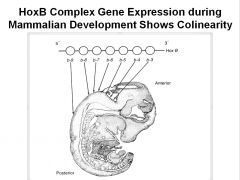
Colinearity refers to the fact that the order of the genes on the chromosome reflects their temporal and/or spatial expression.
|
|
|
Mutations in what gene are responsible for synpolydactyly?
|
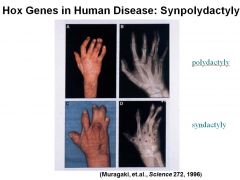
Mutations in the HOX-D13 (expansion of a polyalanine stretch in the terminal region of HOX-D13) are associated with synpolydactyly.
|
|
|
What is sclerotome?
|
Sclerotome is the embryonic precursor to the vertebral bodies and ribs.
|
|
|
What happens if Hh is mutated (what type of phenotype is produced)?
|
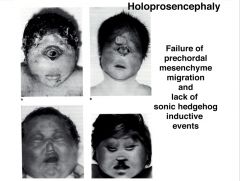
Hh inhibits Ptc, and the negative regulation of the pathway by Ptc is removed, so that the pathway becomes active. This results in holoprosencephaly, an abnormality in the development of the ventral embryonic forebrain, causing abnormal septation of the cerebral hemispheres (abnormality in the patterning of the CNS).
|
|
|
What happens if Ptc (Patched) is mutated?
|

Patched mutations leads to constitutive pathway activation and causes basal cell nevus syndrome. This includes skull and rib abnormalities and a predisposition to cancer (abnormality in skeletal patterning and cell growth).
|
|
|
What happens if GLI3 is mutated?
|
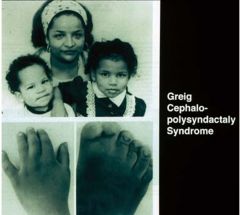
GLI3 mutation is associated with cephalopolysyndactyly or polydactyly (abnormality in patterning of the extremities +/- CNS).
|
|
|
The spatial and temporal expression of HOX genes does what?
|
The specific spatial and temporal expression of HOX genes establishes anterior-posterior embryonic axis.
|
|
|
What does the Shh-Ptc pathway establish in the embryo?
|
The Shh-Ptc pathway establishes a dorsal-ventral axis in the developing CNS and somites and an anterior-posterior axis in the developing limb by establishing concentration gradients from “organizing centers.”
|
|
|
What is posterior dominance?
|
If two HOX genes have overlapping expression patterns, the HOX gene whose expression ends further posterior will be dominant over the HOX gene whose expression pattern extends more anterior.
|
|
|
What enzyme deficiency is responsible for Tay-Sachs disease?
|
A deficiency in hexosaminidase A causes Tay-Sachs disease
|
|
|
What is the major accumulating lipid in Tay-Sachs disease?
|
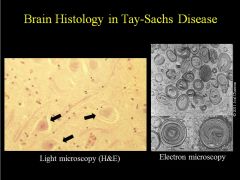
The major accumulating lipid in Tay-Sachs disease is GM2. It accumulates in the neurons.
|
|
|
What 3 proteins do you need for normal function in the degradation of GM2 to GM3?
|
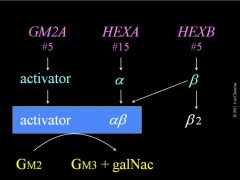
For degradation of GM2 to GM3, you need activator, alpha, and beta.
|
|
|
What is the functional role of activator in the degradation of GM2?
|
Activator serves as a detergent that allows GM2, which is a lipid and hydrophobic to interact with hexosaminidase A, which is a hydrophilic protein.
|
|
|
What is the functional role of beta in the degradation of GM2?
|
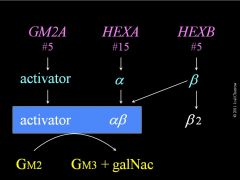
Beta dimerizes with alpha to form hexosaminidase A. Both alpha and beta are necessary to form hexosaminidase A. Deficiency in either alpha, beta, or activator leads to Tay Sachs disease. Beta dimerizing with itself forms hexoaminidase B. Sandhoff is produced by lack of both hexosaminidase A and B. Tay-Sachs is produced by lack of alpha (which means no hexosaminidase A), and an AB variant is produced by a lack of activator.
|
|
|
All Jews of reproductive age should be tested to determine if they carry what gene?
|
All Jews of reproductive age should be tested to determine if they carry a Tay Sachs Disease gene
|
|
|
What are characteristic features of mucopolysaccharidosis I?
|
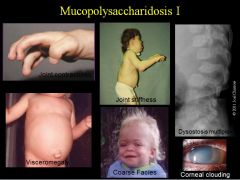
Elongated head shape (frontal bossing), visceromegaly, joint stiffness, coarse face, dystosis multiple (abnormal spinal column), corneal clouding.
|
|
|
What is allelic heterogeneity?
|
Allelic heterogeneity is when different mutations (different alleles) produce different phenotypes, which are related to mutations in the same genes.
|
|
|
What is Locus heterogeneity?
|
Locus heterogeneity is when there are similar phenotypes caused by mutations in different genes at different loci.
|
|
|
How do you treat the accumulation of Ammonia diseases?
|
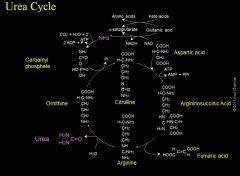
You can supply the depleted enzymes, and the argininosuccinic acid gets excreted (as opposed to urea), and the ammonia will not build up.
|
|
|
What is the pathogenesis of the biotin-related disease?
|
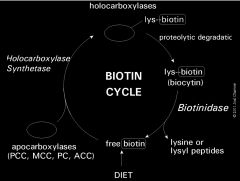
The newborns have a deficiency in biotinidase, which is responsible for regenerating biotin in the body by breaking the bond between biotin and the carboxylases. The biotin is then used to biotinylate the apocarboxylases. A certain amount of biotin is ingested regularly, but it’s not enough to meet the needs. However, increased biotin in the diet (10mg/day), can relieve the body for the need to regenerate biotin.
Clinical manifestations include hair loss, seizures, neurological deficits, skin rash, hearing impairment (all called multiple-carboxylase deficiency). (picture of slide 45). |
|
|
What was the enzyme missing in the galactose metabolism disorder discussed in the autosomal recessive disease lectures?
|

We discussed galactosemia in lecture. A deficiency in Galactose-1-phosphate transferase leads to accumulation of galactose-1-phosphate which results in liver disease (jaundice, cirrhosis, ascites, liver failure), diarrhea, bone marrow suppression which can culminate in early death if not recognized and treated. Even after removing lactose from the diet, there’s endogenous galactose production, and there are residual phenotypic effects (e.g., learning disabilities and trouble with language, and 90-95% of women have primary ovarian failure and many will not feminize due to inadequate production of sex hormones).
|
|
|
What is the clinical manifestation of galactosemia?
|

Galactosemia is a by-product of Gal-1-P uridyl transferase deficiency. It results in cataracts in the eyes, caused by galactitol, which is normally not present in significant amounts.
|
|
|
What causes I cell disease?
|
I cell disease is an autosomal recessive lysosomal storage disease. It is caused by a deficiency of UDP-N-acetylglucosamine transferase, which acts on many lysosomal enzymes; in its absence, the enzymes lack the mannose-6-phosphate recognition marker necessary for transport and packaging of hydrolase receptors to lysosomes. As a result, the hydrolase enzymes “leak” out of the cells into the ECF, and intracellular levels of multiple lysosomal enzymes are deficient. Substrates accumulate, and the phenotype is similar to Hurler Syndrome.
|
|
|
What are the possible consequences of enzyme deficiencies which can produce disease?
|
• Accumulation of substrate
o Mucopolysaccharidoses GAGs in the lysosome o Tay-Sachs Disease GM2 in neurons o I-cell Disease various o Glycogen storage glycogen o Urea cycle Ammonia o Propionic academia Propionyl-CoA, propionic acid, other organic acids derived from propionyl CoA • Deficiency of product o Glycogen storage Glucose o Biotinidase deficiency • Toxic effects of abnormal metabolites o Galactosemia galactitol |
|
|
What does haploinsufficiency mean?
|
Haploinsufficiency is when being heterozygous is not sufficient for the appropriate function of the gene product.
|
|
|
What is dominant negative protein suicide?
|
A defunct gene product (i.e. a protein) gets degraded rather than put into use.
|
|
|
Name an example of protein suicide given in the lecture and the pathophysiologic mechanism.
|
One example from the lecture of protein suicide was for Osteogenesis Imperfecta, the mild type, whereby improperly formed type I collagen is degraded resulting in decreased levels of collagen and increased elasticity.
|
|
|
What is the mechanism of death for the severe form of Osteogenesis Imperfecta?
|
Babies die from respiratory failure caused by broken ribs and inability to expand the lungs (a rigid chest wall is necessary for lung expansion).
|
|
|
Which disease produces a phenotype blue sclera?
|
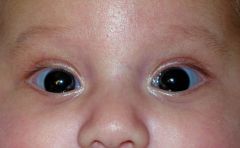
Osteogenesis Imperfecta has the phenotype of blue sclera, produced by a defect in collagen type I.
|
|
|
What is the most common cause of dwarfism?
|
Achondroplasia; the disease with the “Spock” hand or “Trident” hand.
|
|
|
What is the definitive treatment for homozygotes of familian hypercholesterolemia?
|
Liver transplant is the definitive treatment for homozygotes of familian hypercholesterolemia.
|
|
|
What type of mutation is the Insulin Chicago?
|
Insulin Chicago is a dominant negative mutation.
|
|
|
Which of the following is not an inherited autosomal dominant disorder:
• Familial Hypercholesterolinemia • Insulin Chicago • Achondroplasia • Wolf-Hirschhorn Syndrome • Familial Male Precocious Puberty |
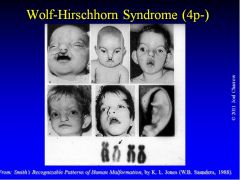
Wolf-Hirschhorn Syndrome is not inherited (the one with the “greek warrior helmet” appearance).
|
|
|
What is the mechanism of pathogenesis in Familial Hypercholesterolinemia?
|
In Familial Hypercholesterolinemia, there’s a defunct LDL receptor, leading to high circulating levels of cholesterol (normal is 200).
|
|
|
True/False: haploinsufficiency for FGFR3 causes achondroplasia.
|
False
|
|
|
True/False: There’s a considerable amount of allelic heterogeneity in Achondroplasia.
|
False; >98% of patients have Gly -> Arg at position 380 (same mutation).
|
|
|
What is the genetic basis for achondroplasia?
|
In achondroplasia, there’s a single base substitution resulting in Glycine->Arginine at position 380 of the gene product of the fibroblast growth factor receptor 3 (FGFR3) gene found in more than 98% of individuals with achondroplasia. FGFR3 acts as a negative regulator of chondrocyte proliferation and differentiation at the growth plate; the achondroplasia mutation apparently constitutively activates this function, i.e., results in a gain of function.
|
|
|
Why don’t women have precocious puberty in familial male precocious puberty?
|
LH by itself is not sufficient.
|
|
|
What type of mutation produces Familial male precocious puberty, and what is the mechanism?
|
Familial male precocious puberty is a gain of function mutation. Mutations in the LH-receptor can cause a conformational change in the receptor comparable to what occurs when LH is bound to it. The result is a constitutively activated receptor signaling action even in the absence of its hormone and the testicular production of testosterone beginning at a very young age.
|
|
|
Where does the mitotic spindle attach?
|
The mitotic spindle attaches to the centromere.
|
|
|
What’s the only thing that puts a child at increased risk for chromosomal abnormality?
|

There’s only one thing we know of that puts a child at increased risk for chromosomal abnormality, and it’s maternal age
|
|
|
What is the most common chromosomal abnormality?
|
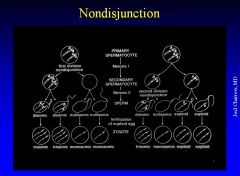
The most common chromosomal abnormality is trisomy, caused by nondisjunction. The second most common and important is reciprocal translocation (exchange of chromosome material between two chromosomes)
|
|
|
How do Robertsonian translocations relate to reciprocal translocations?
|
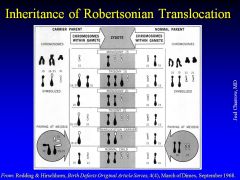
Robertsonian translocations are similar to reciprocal translocations, except they only involve acrocentric chromosomes (chromosomes with really short arms).
|
|
|
If a patient has Down’s syndrome from a Robertsonian translocation, what are the odds the parents have Down’s or are carriers?
|
Not likely, because Robertsonian translocation causes of Down’s are largely de novo mutations.
|
|
|
What are the symptoms of Down’s syndrome?
|

General: hypotonia (low muscle tone), open mouth, protruding tongue
CNS: mental retardation (some will read, not all) Craniofacial: brachycephaly (short A-P diameter of the skull), flat occiput, upward slanting palpebral fissures Eyes: brushfield spots, epicanthal fold (extra fold of skin—abnormal for Europeans) Ears: small pinnae, small lobule, overfolding of upper helix Hands: short fingers (brachydactyly), single flexion crease, brachymesophalangia, transverse palmar crease Feet: wide gap between 1st and 2nd toes Heart: anomaly in 30-40% (AV-Canal, VSD); congenital heart disease is very common GI: duodenal and other bowel atresias (the congenital absence or pathological closure of an opening, passage, or cavity) Skin: cutis marmorata (pink rings—a vascular phenomenon) GU: small penis, infertility in males (females fertile) |
|
|
What are symptoms of Trisomy 13?
|
CNS: holoprosencephaly/incomplete forebrain development, severe mental deficiency, seizures, apnea, sensorineural deafness
Craniofacial: scalp defects, microcephaly, sloping forehead, wide sutures, large fontanelles, redundant skin on neck Eyes: microphthalmia, colobomata of iris, retinal dysplasia Mouth: cleft lip, palate or both Hands and feet: simian crease, narrow hyperconvex nails, camptodactyly (contracted fingers), post-axial polydactyly, prominent heels Cardiac: VSD, PDA, ASD, dextroposition Genitalia: cryptorchidism (undescended testes), abnormal scrotum, bicornuate uterus Skin: hemangiomas |
|
|
What is the prognosis for Trisomy 13?
|
Mortality:
55% by 1 month 70% by 6 months 82% by 12 months Management is to offer nutrition, and that’s about it. They die of respiratory failure. |
|
|
What is the only viable monosomy?
|
The only viable monosomy is monosomy for the X-chromosome (Turner's syndrome).
|
|
|
What causes the methylation of CpG islands in FMR-1?
|
The expansion of the CGG repeats causes methylation of the CpG islands in FMR-1.
|
|
|
How many repeats of CGG are necessary to cause the disease state in Fragile-X Syndrome?
|
>200 (>230) repeats of CGG are necessary to produce the phenotype of disease for reduced transcription of the FMR-1, FMR-1 deficiency and Fragile X syndrome.
|
|
|
What type of disease is Fragile-X Syndrome (autosomal recessive, x-linked, etc.)?
|
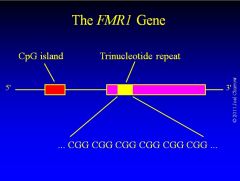
Fragile-X Syndrome (caused by deficient FMR-1) is considered autosomal dominant with limited penetrance (53%).
|
|
|
What genetic phenomenon explains why transmitting males of the Fragile-X Syndrome syndrome would not have daughters with the phenotype, but they would have grandchildren with the phenotype?
|
Anticipation: the occurrence of a genetic trait at an earlier age or greater severity in succeeding generations. Expansion of the CGG repeats would occur only during female oogenesis, not during mitosis or male spermatogenesis.
|
|
|
Do the trinucleotide repeats for FMR-1 occur in the coding or noncoding portion of the gene?
|
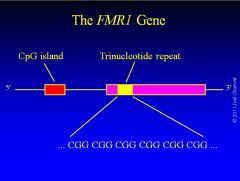
Noncoding.
|
|
|
Which trinucleotide repeats occur in the coding region? Non coding region?
|
Coding: Huntington Disease, Spinal & Bulbar Muscular Atrophy (Kennedy Disease)
Non-coding: Fragile-X Syndrome, Myotonic Dystrophy, Friedreich’s ataxia |
|
|
What is the most common inherited ataxia?
|
Friedreich’s ataxia is the most common inherited ataxia.
|
|
|
What is the genetic cause of Friedreich’s Ataxia?
|
Friedreich’s Ataxia is caused by an expansion of a GAA repeat in the first intron of the frataxin gene on chromosome 9. It is an autosomal recessive disease.
|
|
|
What are symptoms of Friedreich’s Ataxia?
|
1) Ataxia in all four limbs
2) Cerebellar dysarthria 3) Absent reflexes, sensory loss, pyramidal signs 4) Cardiomyopathy, skeletal deformities 5) Glucose intolerance/diabetes |
|
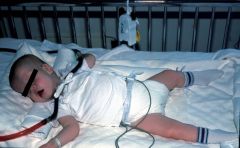
What is the genetic cause of the congenital form of Myotonic Dystrophy?
|
Myotonic dystrophy is caused by a CTG repeat (>1000) in a 3’ untranslated region of a protein kinase. It is an autosomal dominant disease.
|
|
|
What are symptoms of the congenital form of Myotonic Dystrophy?
|
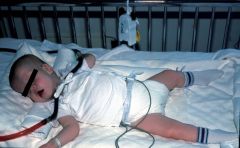
Progressive weakness and myotonia, cataracts, arrhythmia, hypogonadism, male pattern baldness, cognitive impairment
|
|
|
In Complete Androgen Insensitivity Syndrome, what causes the female secondary sexual characteristics?
|
Aromatization of androgens to estrogens results in female secondary sexual characteristics.
|
|
|
What are symptoms of Kennedy Disease?
|
Slowly progressive loss of spinal cord and bulbar motor neurons, weakness of proximal skeletal muscles, bulbar muscles, and facial musculature, striking gynecomastia is the first sign, reduced fertility and testicular atrophy. Individuals are invariably raised as females because of their normal appearing female external genitalia.
|
|
|
What is the genetic cause of Spinal and Bulbar Muscular Atrophy/Kennedy Disease?
|
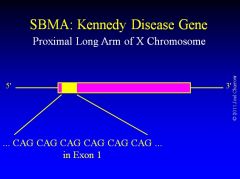
Kennedy disease is caused by a CAG repeat in the coding region, exon 1 (of the androgen receptor). Kennedy Disease is X-linked recessive. It is deemed a gain of function mutation, but the mechanism is unknown.
|
|
|
What trinucleotide repeat disorder is a common cause of mental retardation?
|
Fragile-X syndrome is one of the most common genetic causes of mental retardation.
|
|
|
When does organogenesis occur?
|
Organogenesis occurs 2-8 weeks after conception. This is when most teratogens have their effects.
|
|
|
How does maternal diabetes mellitus affect the development of the fetus?
|
Maternal DM increases the risk of congenital malformations 3-fold, especially affecting the spine and lower extremities, heart, kidneys, and CNS. The rate of miscarriage is also increased as well as preterm fatal demise.
|
|
|
How does maternal Diabetes Mellitus affect the infant?
|
The infant of a diabetic mom may be large for gestational age, plethoric (inflated), and prone to neonatal hypoglycemia. Infants with mom’s with vascular compromise due to DM can have placental insufficiency and growth retardation.
|
|
|
What are potential adverse effects of maternal phenylketonuria?
|
The exposed fetus to high levels of phenylalanine has a >90% chance of mental retardation, and microcephaly and congenital heart defects are very common. Tight control of diet is necessary throughout pregnancy.
|
|
|
What magnitude of radiation characterizes high doses of energy that could damage the fetus?
|
>200cGy during the period 2-5 weeks after conception can result in intrauterine growth retardation, CNS damage, and ocular defects.
|
|
|
What are the TORCH pathogens?
|
- Toxoplasmosis
- O (syphilis) - Rubella - Cytomegalovirus - Herpes |
|
|
What malformations do thalidomide, phenytoin, and trimethadione produce?
|

• Thalidomide produces phocomelia
• phenytoin produces nail and 5th finger hypoplasia • Trimethadione produces cleft palate |
|
|
Is animal testing useful for determining which agents are teratogens? Why or why not?
|
No. Different strains of animals have different susceptibilities to specific teratogens.
|
|
|
Given an example where a person’s genotype could affect drug metabolism and hence the effect of a teratogen on phenotype.
|
Embryos homozygous for decreased epoxide hydrolase activity are more likely to be affected by the fetal hydantoin syndrome
|
|
|
What is the “all or none” period, and when is it?
|
First two weeks.
|
|
|
What is the mechanism for Warfarin Embryopathy?
|
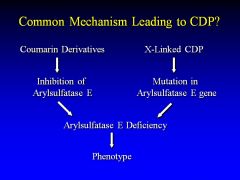
Coumarin derivatives interfere with Arylsulfatase E, and deficient Arylsulfatase E results in the phenotype (abnormal nose, digits, etc.).
|
|
|
What is a disease with a similar phenotype as Warfarin Embryopathy, and what are the characteristics of the disease?
|
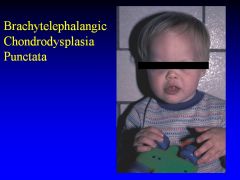
Chondrodysplasia punctate is a phenocopy of Warfarin Embryopathy. It is X-linked recessive, brachytelephalangic type, and symptoms include the following:
• Hypoplasia of nasal cartilage • Short distal phalanges • Small nails • Chondrydysplasia punctate • Short stature |
|
|
What is a malformation?
|
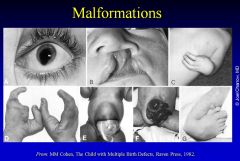
A malformation is a morphologic defect in an organ, part of an organ, or area of the body resulting from an intrinsically abnormal developmental process (e.g., cleft lip, polydactyly).
|
|
|
What is a deformation?
|
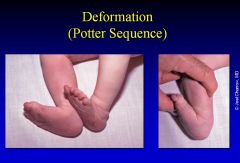
A deformation is an abnormal form or position of a part of the body caused by non-disruptive mechanical forces (e.g., club foot, mandibular asymmetry).
|
|
|
What is a disruption?
|

A disruption is a defect in an organ or part of an organ or a larger region of the body resulting from a breakdown of or an interference with, an originally normal developmental process (e.g., amniotic bands). Disruptions result in loss of tissue.
|
|
|
Why is it important to search for minor anomalies in newborns?
|
1. In newborns with 3 or more minor anomalies, 90% have major anomaly.
2. Minor anomalies are present in many multiple congenital anomaly syndromes. 3. 42% of idiopathic mental retardation cases have 3 or more anomalies, 80% of which are minor anomalies. |
|
|
What are examples of malformations?
|
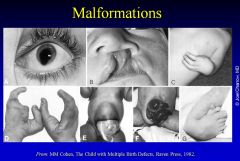
Lobster claw, ampholocele, cloacal extrophy, redundant morphogenesis
|
|
|
What was an example given in lecture of a malformation sequence?
|
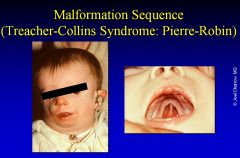
Treacher’s syndrome
|
|
|
What was an example of a deformation sequence given in lecture?
|
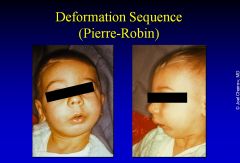
Pierre-Robin
|
|
|
Which method of gene delivery requires dividing cells?
|
Ex vivo gene delivery requires dividing cells whereas in vivo delivery can be into differentiated nondividing cells as well as dividing cells.
|
|
|
What are the 4 types of gene therapy?
|
1) Augmentation
2) Directly alter/repair the defunct gene via homologous recombination 3) Add missing function/regulate expression of another gene (e.g., cancer, cytokine gene) 4) Silence or inhibit expression of a bad gene (for triplet repeat diseases or dominant mutations) |
|
|
What 3 things do you need to conduct a gene therapy protocol?
|
1) Identification of the gene involved in the disease and knowledge of protein product/function
2) A wild type allele (not hard since we’ve sequenced the genome) 3) A convenient method to target WT gene to appropriate site |
|
|
What are the integrating vectors?
|
1) Retrovirus (can target dividing cells only)
2) Lentivirus (can target dividing and non-dividing cells) |
|
|
What are the non-integrating vectors?
|
1) Herpes virus
2) Adenovirus 3) Adeno-associated virus 4) DNA (naked, liposomal complex) |
|
|
What does cell tropism refer to?
|
Cell tropism refers to the way in which different viruses/pathogens have evolved to preferentially target specific host species, or specific cell types within those species.
|
|
|
What’s the disadvantage of a retrovirus? A lentivirus?
|
Retroviruses can only integrate into dividing cells, and lentiviruses are HIV, essentially.
|
|
|
Where is the concentration of Shh highest?
|
The concentration of Shh is greatest closest to the notochord or closest to the zone of polarizing activity in the limb and decreases with greater distance. This establishes concentration gradients, which establish axes.
|
|
|
From where is Shh secreted?
|
Shh is secreted from “organizing” or patterning centers during development, including the notochord and the zone of polarizing activity in the developing limb bud.
|
|
|
Which does the dorsally diffusing Shh produce?
|
Shh that diffuses dorsally induces the development of the adjacent ectoderm into the neural tube. In turn, the highest concentrations of Shh induce adjacent ectoderm into the differentiation of the ventral floor plate and motor neurons in the ventral neural tube. Lower concentrations of Shh in the dorsal neural tube are associated with the development of sensory ganglia/neurons.
|
|
|
What does the lateral diffusion of Shh produce?
|
Shh that diffuses laterally from the notochord affects the development of the adjacent somites. The ventral-medial somite, which is closest to the notochord and sees a higher concentration of Shh, differentiates into sclerotome (the precursor of the vertebral bodies and ribs). The dorsal lateral somite, farthest from the notochord and with lowest cenctrations of Shh, develops into dermomyotome (precursor of dermis and body musculature).
|
|
|
What is the pathogenic mechanism of mucopolysaccharidoses, and what is the disease phenotype?
|
Mucopolysaccharidoses are characterized by defective lysosomal degradation of GAGs, which causes the accumulation of GAGs which damage tissues. Progressive mental retardation is present in most, as is dystosis multiplex, a distinctive bone dysplasia which impairs bone growth and modeling. Corneal clouding is common, and massive enlargement of RES tissues (e.g., liver and spleen) also occurs.
|
|
|
What is the pathogenic mechanism of propionic acidemia, and what is the disease phenotype?
|
Propionyl-CoA is an intermediate in the degradation of a variety of amino acids. It’s normally converted to methymalonyl CoA and then succinyl-CoA, which is further catabolized in the citric acid cycle. Deficiency of propionyl-CoA carboxylase results in accumulation of propionyl-CoA, propionic acid, and several other organic acids derived from propionyl-CoA, causing episodic acidosis, which may be injurious to the CNS and otherwise life threatening.
|
|
|
What is the difference between the early onset form of multiple carboxylase deficiency and the late onset form of multiple carboxylase deficiency?
|
In the early onset form (first few days of life), there is a deficiency in holocarboxylase synthetase, and the phenotype is characterized by vomiting, lethargy, hypotonia, and abnormal excretion of organic acids. In the late onset form (3-6 months), there’s a deficiency in biotinidase, and the phenotype is characterized by skin rash, conjunctivitis, alopecia, and developmental delay in addition to the organic aciduria.
|
|
|
What is the means of pathogenesis in Ehlers-Danlos syndrome?
|
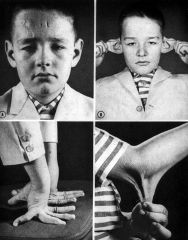
Ehlers-Danlos syndrome is an example of protein suicide where, in the less severe form of osteogenesis imperfecta, the defunct collagens are degraded, and the individual merely has less collagen than normal as opposed to the severe case where the bad collagens are used.
|
|
|
How many CTG trinucleotide repeats would it take to classify someone as having the congenital form of myotonic dystrophy?
|
1000
|
|
|
Which treatment, in vivo or ex vivo, would have to be repeated?
|
In vivo would have to be repeated, while ex vivo would persist for life (although it may not always be expressed).
|
|
|
What’s a disadvantage of an adenovirus? Adeno-associated viruses?
|
Adenovirus: can elicit immune response which would limit effectiveness (could be helpful for cancer, though). Adeno-associated virus: small capacity for foreign genes.
|
|
|
What is pseudo-typing?
|
Pseudo-typing is when you change where the virus will target by changing the envelope protein from what normally would be used to something else.
|
|
|
What are disadvantages of using plain DNA for gene therapy?
|
Although DNA is simple, relatively safe, and lacks a specific immune response, it is relatively inefficient, because not enough gets into the cell or cell nucleus. There’s typically a “patchy,” transient expression.
|

